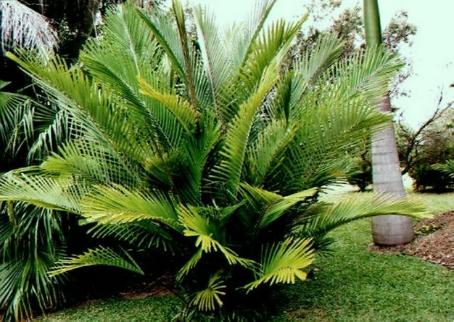Live Green, Love Green, Think Green
South Florida Landscape Plants
| Arenga Palm Arenga engleri/Arenga tremula The attractive, out-of-the-ordinary arenga palm is one of the most unique and under-used palm trees in Florida. Arenga palm growing next to house Arengas are multi-trunk, clustering palms with an unusual growth habit - short and wide-spreading - that makes them a great alternative to a shrub hedge. You can use an arenga - sometimes called "Dwarf Sugar Palm" - almost as you would a large, wide-spreading shrub yet one with a decidedly tropical look.Long, large-leafed fronds with silvery undersides contrast well with the textures and colors of other plantings. Or...as an understory plant in a garden shaded by trees or taller palms, an arenga palm tends to spread less and makes an outstanding stand-alone specimen. Plant specs Young palm in sunny garden Dwarf sugar palms are slow-growing. They can reach an average height of about 8 feet tall and 8 feet wide (in shade) to 15 feet wide (in sunnier locations). These cold-tolerant palms thrive almost anywhere in South Florida - from Zone 9B and southward. Though full sun is fine - where it will grow slightly faster - the arenga keeps its best deep green color in partial to full shade. Plant care Amend the soil with organic peat moss or top soil when you plant. Arenga palms like a regular watering though they don't like "wet feet." Plant a bit on the high side if the area isn't well-drained. As it matures, an arenga forms aerial roots that push it above the soil surface, which helps provide good drainage for the health of the plant. Apply palm fertilizer at least 3 times a year, in spring, summer and fall...and if the palm is planted in full sun, fertilize more often (up to once a month in warmer weather). In a full sun location, this palm's fronds tend to turn lime-green or yellow, so the extra fertilization helps prevent this discoloration. These palms aren't considered self-cleaning but you'll only need to trim off an old frond occasionally...or side shoots if you want to keep it less wide. Large palm by house Plant spacing Even though its fronds can extend an average of 6 feet or more, this is one palm you can plant as close as 3 feet from the house. Cut off any fronds along the back that touch the wall. Very young palm For a privacy screen or hedge, space the plants 3 to 6 feet apart depending on the density you want. The fronds will merge together in tight-knit plantings. As a stand-alone specimen, it will spread its wings, so to speak, so allow enough room for you to get by it comfortably as it matures. These make excellent container palms because of their slow growth rate. Landscape uses for arenga palm privacy screen along a patio, pool or anywhere you need one hedge plant single specimen accent for corners provide interest along tall blank walls covering a fence container palm |

